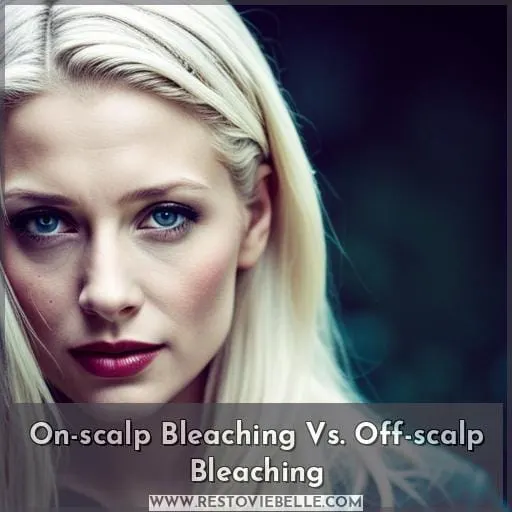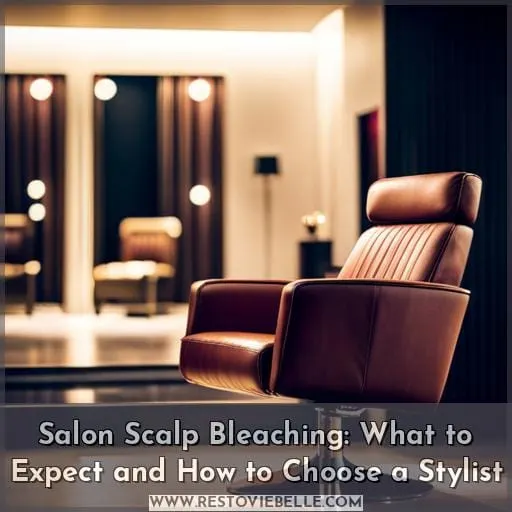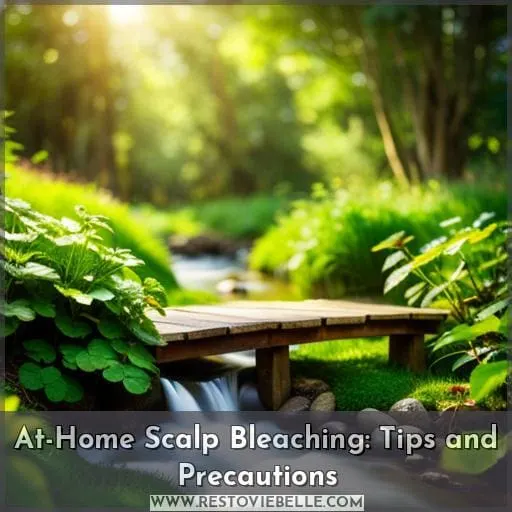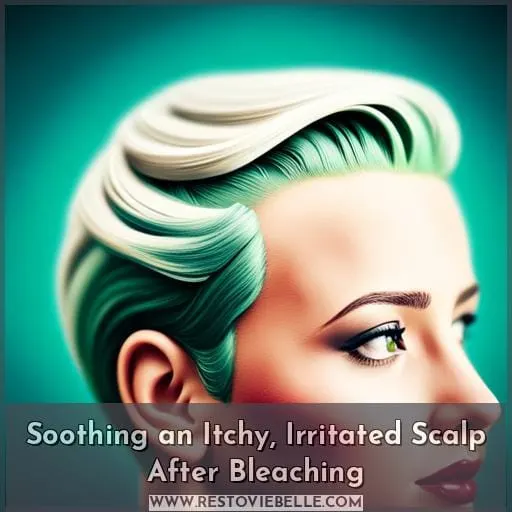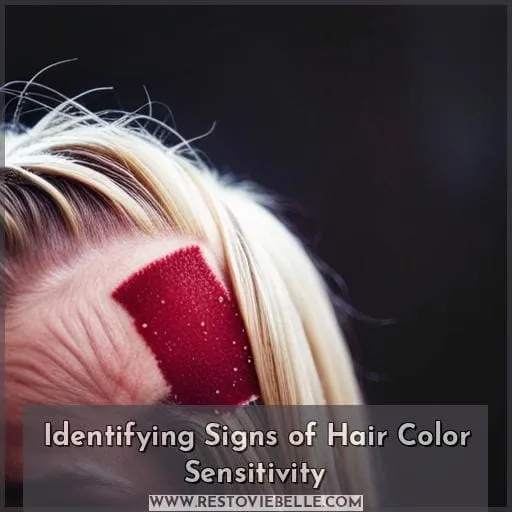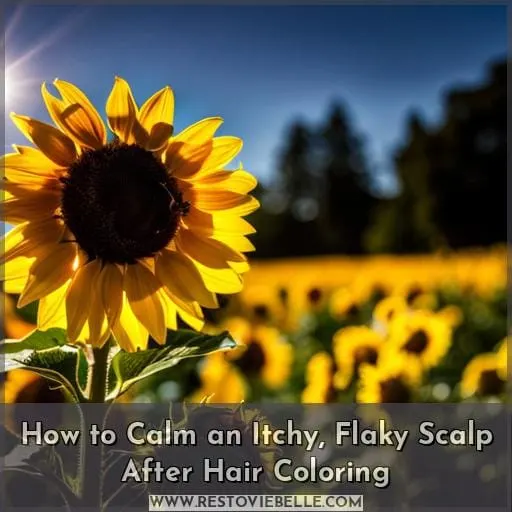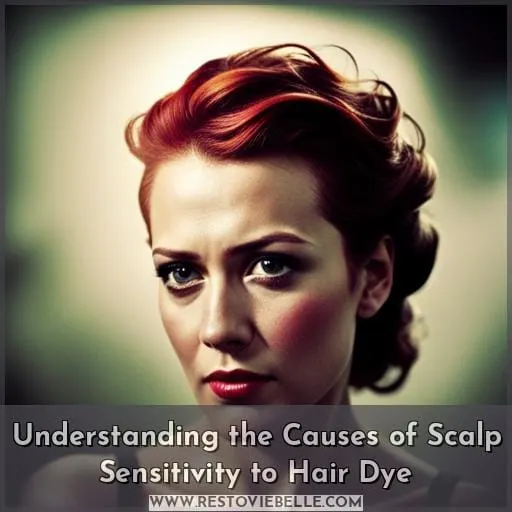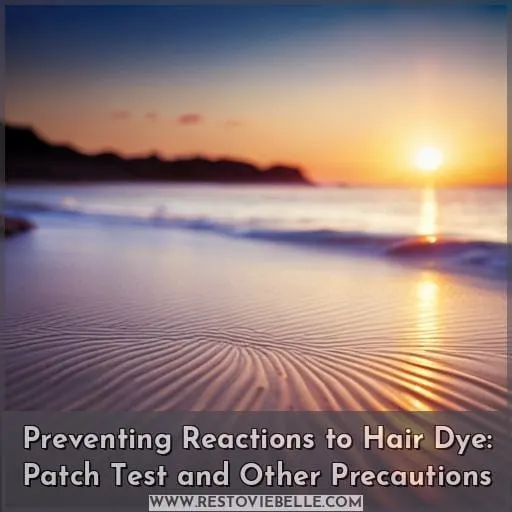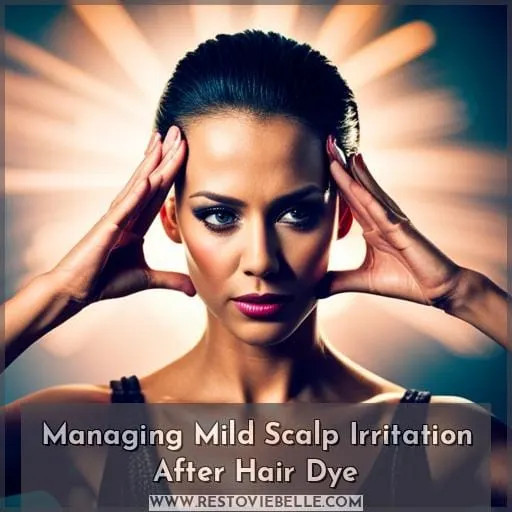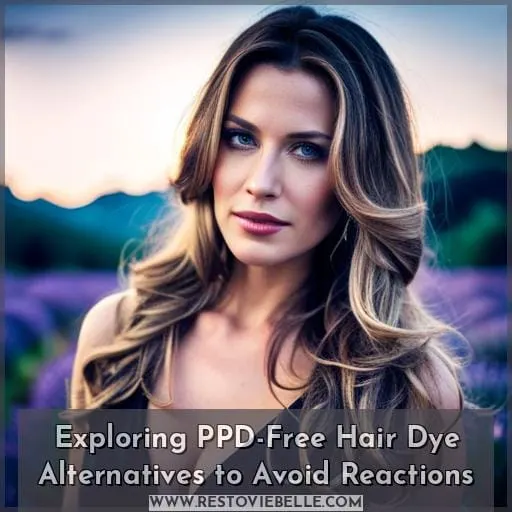This site is supported by our readers. We may earn a commission, at no cost to you, if you purchase through links.
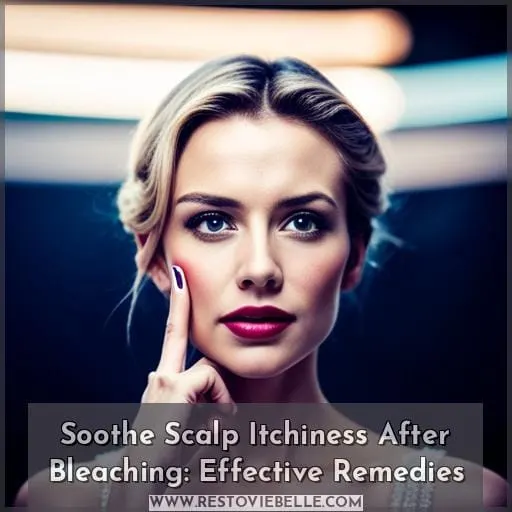 Whether you did it in a salon or DIY’d it at home, bleaching your scalp can result in irritation and itchiness that feels crazy-making. We understand; you were hoping for an edgy, bleached scalp à la Kim K, but instead you’re stuck with an itchy mess.
Whether you did it in a salon or DIY’d it at home, bleaching your scalp can result in irritation and itchiness that feels crazy-making. We understand; you were hoping for an edgy, bleached scalp à la Kim K, but instead you’re stuck with an itchy mess.
Fortunately, you don’t need to live with the discomfort. There are effective remedies that’ll soothe that irritated scalp and let you rock your new ‘do in peace. Keep reading to learn how lemon juice and other home remedies you can use to find sweet relief from your post-bleach scalp struggles.
Table Of Contents
- Key Takeaways
- On-scalp Bleaching Vs. Off-scalp Bleaching
- Salon Scalp Bleaching: What to Expect and How to Choose a Stylist
- At-Home Scalp Bleaching: Tips and Precautions
- Soothing an Itchy, Irritated Scalp After Bleaching
- Identifying Signs of Hair Color Sensitivity
- How to Calm an Itchy, Flaky Scalp After Hair Coloring
- Understanding the Causes of Scalp Sensitivity to Hair Dye
- Preventing Reactions to Hair Dye: Patch Test and Other Precautions
- Managing Mild Scalp Irritation After Hair Dye
- Exploring PPD-Free Hair Dye Alternatives to Avoid Reactions
- Conclusion
Key Takeaways
- Use natural remedies such as lemon juice, apple cider vinegar, chamomile tea, and honey to soothe scalp itchiness after bleaching.
- Incorporate effective post-bleaching scalp care, including aloe vera and a moisturizing conditioner, to alleviate discomfort.
- Avoid overprocessing and maintain scalp health by following proper aftercare tips.
- Consider PPD-free hair dye alternatives, like henna or vegetable-based dyes, to prevent scalp reactions in the first place.
On-scalp Bleaching Vs. Off-scalp Bleaching
You’re gently dabbing a cool compress on the irritated areas after rinsing the bleach thoroughly, being careful not to rub or scratch. With on-scalp bleaching, the bleach touches your actual scalp during application.
This gives maximum lightening but can irritate sensitive skin. Off-scalp bleaching keeps the bleach mixture lifted off your scalp. This protects the scalp but may compromise results. Either method can cause irritation from the harsh chemicals interacting with the scalp and hair.
It’s important to choose an experienced stylist who can minimize scalp sensitivity. They should section hair properly and follow timing directions. Thoroughly rinsing aftercare is crucial, as is using soothing treatments and avoiding repeat bleaching.
Salon Scalp Bleaching: What to Expect and How to Choose a Stylist
Get recommendations and check reviews before choosing a styling salon for scalp bleaching. Look for stylists who are licensed professionals with considerable bleaching experience to ensure proper application and scalp care.
Make sure you feel informed and comfortable before proceeding with an on-scalp lightening service.
Choosing a Qualified Stylist
First, verify that the stylist is board-certified by your state if you want to safely bleach your hair. Check their certification on your state cosmetology board’s website to ensure they have an active license.
Before booking an appointment, rely on the stylist’s portfolio, online reviews, and salon client feedback. Ask the stylist questions about their bleaching technique, risk management protocols, and post-care recommendations.
Opt for stylists with specialized training and experience safely handling scalp bleaching. The stylist should screen for any pre-existing scalp conditions and adjust their process accordingly to reduce irritation.
With proper precautions, a skilled stylist can help minimize scalp sensitivity from bleaching.
Side Effects and Risks
Reviewing the risks, proceed with caution when scalp bleaching to mitigate potential side effects like irritation or even chemical burns. Be aware that harsh chemicals like ammonia and hydrogen peroxide can trigger scalp sensitivity or allergic reactions that manifest as itching and redness.
Proper bleach aftercare is key – perform patch tests, follow directions closely, and condition regularly. For chemical burns, rinse immediately and avoid scratching; seek emergency care if severe. Using gentler lighteners like lemon juice avoids side effects, but takes more time to work.
Post-Bleaching Scalp Care
After that chemical catastrophe turned your scalp into an inferno, coat it in the chilliest creams and aloes available to humanity.
- Rinse hair thoroughly post-bleaching.
- Apply aloe vera gel to soothe irritation.
- Use a moisturizing conditioner to replenish oils.
- Try an anti-itch scalp spray with menthol.
- Consider natural alternatives like lemon juice or chamomile tea.
Applying soothing and hydrating products can help relieve scalp discomfort after bleaching.
At-Home Scalp Bleaching: Tips and Precautions
Let’s cool down that scalp irritation stat using mild shampoo and a cool compress.
- Read labels thoroughly, check for scalp safety
- Wear gloves and follow directions carefully
- Set a timer and don’t exceed recommended time
- Rinse thoroughly, don’t leave bleach on too long
- Condition after to prevent post-bleaching breakage
- Take time between touch-ups for scalp health
- Avoid overprocessing that leads to irreparable damage
When bleaching hair at home, being diligent about product safety, timely rinsing, and post-bleaching care helps maintain your hair’s integrity and prevents irritation. With some simple precautions, you can achieve your desired look while keeping your scalp happy.
Soothing an Itchy, Irritated Scalp After Bleaching
You just bleached your hair and now have an itchy, irritated scalp. Try using lemon juice to help soothe the irritation and relieve itchiness.
Lemon Juice
Try applying lemon juice to your scalp as an alternative to bleaching for lightening hair color – but be sure to ask a professional about any risks. A natural citrus elixir, lemon juice’s acidic properties may provide temporary scalp refreshment and soothe itchiness while lightly lifting hair color.
However, lemon juice’s high acidity could worsen irritation or dryness if improperly used. To avoid potential scalp burns, always dilute lemon juice and limit direct scalp contact.
While homemade haircare with lemon juice may seem harmless, bleach-damaged hair needs special care. Consult a stylist first about lemon juice hair remedies when soothing post-bleaching scalp sensitivity.
Apple Cider Vinegar
You should apply apple cider vinegar diluted with water to your scalp.
- Restores scalp pH balance
- Has natural anti-inflammatory properties
- Helps remove product buildup
Applying diluted apple cider vinegar can help soothe an itchy scalp after bleaching hair. The acetic acid in apple cider vinegar helps restore the scalp’s pH balance. It also has anti-inflammatory properties and helps remove product buildup – all of which can relieve irritation.
Make a solution of equal parts apple cider vinegar and water. Gently massage this into the scalp and rinse thoroughly.
Chamomile Tea
Approximately 35% of people experience an itchy scalp after hair coloring. To provide relief without bleaching again soon, rinse your hair with chamomile tea. Brew a strong batch of chamomile tea and let it cool. After shampooing, pour the tea through your hair as a soothing final rinse.
Chamomile’s anti-inflammatory properties work as a natural remedy to relax your scalp after the irritation of bleaching. This herbal hair care treatment may help relieve post-bleaching scalp reactions without requiring another chemical process.
Honey
After rinsing the bleach out, gently massage some honey into your scalp for its anti-inflammatory properties.
- Antibacterial: inhibits the growth of bacteria and fungi.
- Anti-inflammatory: reduces inflammation and redness.
- Hydrating: moisturizes and softens the scalp.
- pH balancing: brings the scalp back to a healthy pH level.
- Soothing: calms irritation and itchiness.
The natural enzymes and compounds in raw honey make it a great home remedy to soothe an itchy, irritated scalp after bleaching.
Cinnamon
Powdered cinnamon may help relieve scalp irritation after bleaching by reducing inflammation, though results vary.
Making a paste with cinnamon powder and water and applying it to the scalp, leaving it on 15-30 minutes before rinsing, may soothe irritation. Cinnamon’s antioxidant and antimicrobial properties could help, but test a small area first to check for allergic reactions.
| Benefits | Technique | Considerations |
|---|---|---|
| Anti-inflammatory | Mix cinnamon powder and water into a paste | Test on a small area first |
| Antimicrobial | Apply paste to scalp | Rinse after 15-30 mins |
| Soothing | Leave on 15-30 mins | Watch for reactions |
| Antioxidant | Rinse thoroughly | Stop if irritation worsens |
Identifying Signs of Hair Color Sensitivity
If redness, swelling, or itching appear, you’ll have caught early signs of hair color sensitivity.
- Dilated blood vessels and fluid buildup manifest as red, inflamed skin.
- Itching stems from histamine release and irritation of sensory nerves.
- Swelling signals excess fluid from inflammation and leaky blood vessels.
Look for color defects like uneven results or rapid fading as other tip-offs to developing sensitivity. The scalp may feel tight, dry, and flaky from impaired skin barrier function too. Note when symptoms arise relative to application, since delayed reactions past 48 hours point to type IV hypersensitivity.
Scrutinize ingredient lists for ammonia, PPD, and other irritants if these reactions emerge suddenly after years of uneventful coloring. Skin can become sensitized over time. But take preemptive steps like allergy testing and using gentler, ammonia-free hair dye when possible.
Catching problems early allows for timely changes preventing escalation of your sensitivity.
How to Calm an Itchy, Flaky Scalp After Hair Coloring
You’ve got this – be gentle when caressin’ your scalp after hair colorin’.
- Use a natural remedy like lemon juice or apple cider vinegar as a scalp rinse. The acidity can relieve post color itch.
- Take an allergy pill like loratadine to reduce inflammation and itch relief.
- Apply a hydrocortisone cream to flaky areas for soothin’.
- Try a softenin’ shampoo, and avoid shampoos with sulfates.
- Massage natural oils like coconut or argan into your scalp. The moisture prevents flakin’.
Avoid scratchin’, and treat your scalp gently. With some TLC your scalp will be back to normal soon.
Understanding the Causes of Scalp Sensitivity to Hair Dye
You’d be surprised to learn about 35% of folks get an itchy scalp after hair coloring. Understanding the causes behind hair dye sensitivity provides insight into PPD safety. While PPD helps create longer-lasting color, it’s also a common irritant. Reactions range from mild itching to severe swelling or anaphylaxis.
Allergic responses can also worsen with repeated exposure. Using PPD-free alternative hair colors reduces the risks.
Precautions like allergy testing and patch testing identify potential reactions beforehand. Being aware of the causes behind hair dye irritation allows you to color your hair safely and comfortably.
| Cause | Description |
|---|---|
| PPD | Common hair dye allergen, especially in darker shades |
| Other ingredients | Ammonia, resorcinol, and metals can also irritate |
| Allergic response | Immune reaction to ingredients in hair dye |
| Skin barrier issues | Dryness, damage, or conditions make scalp more prone to irritation |
| Repeated exposure | Worsening allergy with each application |
Preventing Reactions to Hair Dye: Patch Test and Other Precautions
It’s prudent to exercise caution when using hair dye. Prior to coloring your hair, conduct a skin patch test for PPD, visit an allergy clinic for chemical testing if warranted, and take additional safety precautions such as following directions, performing strand tests, and keeping epinephrine on hand in case anaphylaxis occurs.
Patch Test
Before using hair dye, you’ll need to do a patch test to check for any allergic reactions.
- Applying a small amount of dye to your inner elbow or behind your ear.
- Leaving it for 24-48 hours and checking for redness or irritation.
- Doing a skin prick test at a doctor’s office if patch test is unclear.
- Not using the dye if you have any reaction during a patch test.
- Being aware that a negative patch test doesn’t guarantee you won’t react later.
- Doing an updated patch test if changing brands or formulas.
Allergy Clinic
Since hair dye reactions can worsen over time, visit an allergy clinic for specialized chemical sensitivity testing. Schedule a consultation to have your scalp and skin evaluated by an allergist. They can perform patch tests with common hair dye irritants like PPD to pinpoint the specific chemicals you may be sensitive to.
This will allow you to avoid reactive ingredients when choosing safer hair color products and prevent severe allergic reactions. With specialized allergy testing, you can color your hair safely and soothe scalp itchiness after bleaching.
Other Precautions
To protect against scalp sensitivity, always patch test before using hair dye and follow recommended usage instructions. Natural remedies like lemon juice can help restore pH balance and soothe irritation.
Gently rub a lemon slice on the scalp before rinsing off. Soften skin with aloe vera gel. Oils like olive and coconut moisturize while lavender and chamomile essential oils calm allergic reactions.
Managing Mild Scalp Irritation After Hair Dye
Suffering from an irritating itchy scalp after hair coloring can be quite frustrating. To alleviate mild symptoms, ensure thorough rinsing of the dye, apply a soothing emollient cream, consider taking an antihistamine for itch relief, and use a gentle shampoo until the irritation subsides.
Relieving Mild Symptoms
Ease that discomfort with simple at-home remedies like using a cool compress and moisturizing your irritated skin.
Here’s how to alleviate mild post-bleaching scalp irritation:
-
Cooling Compress: Soak a cloth in cold water and gently apply it to the affected area. This can help reduce redness and soothe the itch.
-
Scalp Moisturizers: Use a gentle, fragrance-free scalp moisturizer to keep your skin hydrated. Avoid products with harsh chemicals.
-
Lemon Juice: Diluted lemon juice can have a soothing effect. Apply it to the scalp, leave it for a few minutes, and rinse thoroughly.
-
Natural Remedies: Explore chamomile tea, honey, and cinnamon as natural remedies for soothing your irritated scalp.
These simple steps can go a long way in relieving mild scalp irritation after hair bleaching.
Using Steroid Cream
Using a steroid cream can be the ace up your sleeve when combating hair dye sensitivity reactions. These creams contain anti-inflammatory properties that help reduce redness, inflammation, and itching on your scalp.
However, they should be used sparingly and strictly according to a doctor’s recommendations. Steroid cream benefits include quick relief, but it’s essential to perform a patch test first to ensure you don’t have an adverse reaction.
Taking Antihistamine Medicines
Consider taking antihistamine medicines if you’re experiencing discomfort after hair dyeing to help alleviate any allergic reactions. Antihistamines can provide relief from an itchy scalp by blocking histamine, a chemical responsible for itching and inflammation.
However, exercise caution with medication precautions, as some antihistamines may cause drowsiness. Always follow the recommended dosage and consult a healthcare professional if you have any concerns about using antihistamines for scalp issues.
Exploring PPD-Free Hair Dye Alternatives to Avoid Reactions
To avoid the discomfort of allergic reactions, opt for PPD-free hair dye alternatives. If you’ve experienced scalp irritation or itching after using traditional hair dyes containing paraphenylenediamine (PPD), it’s essential to explore safer options.
-
Look for PPD-Free Formulations: Many brands now offer hair dyes that are explicitly labeled as PPD-free. Check the ingredient list on the product packaging to ensure it doesn’t contain this allergen.
-
Consider Henna or Vegetable-Based Dyes: Henna and vegetable-based dyes are excellent alternatives that can provide vibrant colors without the use of harsh chemicals. They are less likely to cause scalp irritations.
-
Opt for Organic and Natural Options: Some organic and all-natural hair colors do not contain PPD or other common irritants. These can be gentler on your scalp and less likely to trigger allergic reactions.
Exploring PPD-free hair dye alternatives can help you enjoy a beautiful hair color transformation without the risk of allergic reactions, ensuring a more comfortable and safe experience for your scalp.
Conclusion
To wrap it all up, if you’ve been dealing with the discomfort of an itchy scalp after bleaching, you’re not alone. Scalp itchiness can be a common aftermath of the bleaching process. Whether you opted for salon bleaching or did it at home, soothing your irritated scalp is essential.
Remember, post-bleaching care is crucial. You can explore various remedies like lemon juice to alleviate that persistent itchiness. Choose what works best for you and always prioritize scalp health in your hair coloring journey.
